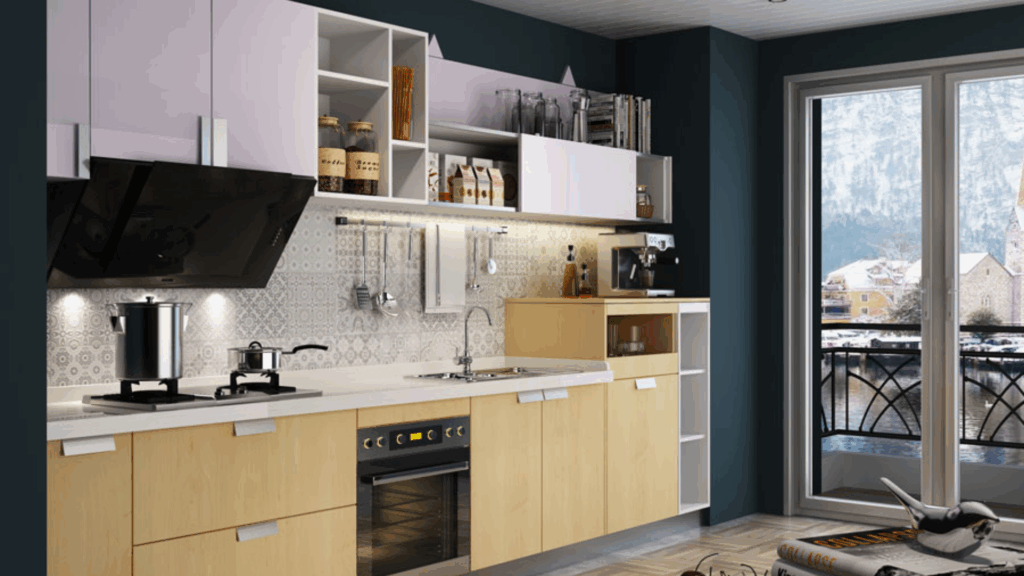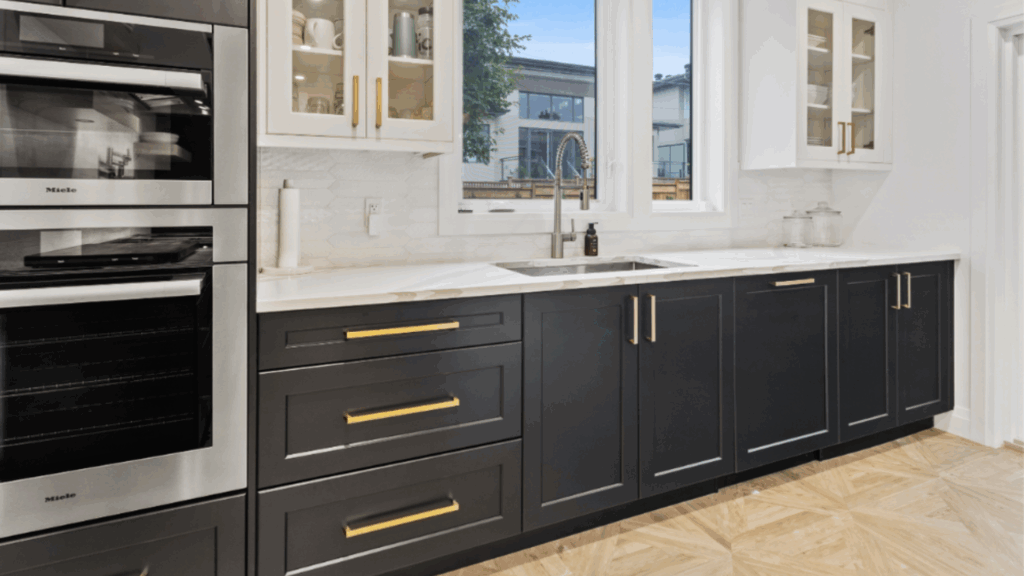I’ve spent a lot of time looking into kitchen cabinet options, and using a cost calculator made a big difference in planning my budget.
It helped me understand the real kitchen cabinets cost, materials, labor, and extras, before getting too deep into shopping or installation.
In this post, I’ll walk you through everything I learned. You’ll see how to use a calculator, what affects pricing, and what to expect from stock, semi-custom, or custom options.
I’ll also share helpful tools and tips that worked for me during my own renovation.
If you’re trying to make smart choices and avoid budget surprises, this guide will keep things clear and manageable.
I’ve been through it myself, so I know how helpful it is to get upfront cost details you can rely on from the start.
What Is a Cost Calculator and Why Does It Matter?
A kitchen cabinet cost calculator is a digital tool that estimates how much your new cabinets might cost based on your selections and layout.
It considers factors like linear feet, cabinet type (stock, semi-custom, or custom), local labor rates, and optional upgrades like soft-close drawers or decorative trim.
Benefits of using a kitchen cabinet cost calculator include:
- Sets a Clear Budget: Gives you a realistic estimate before you start spending.
- Explores Options Easily: Lets you test different materials, layouts, and features to compare prices.
- Avoids Surprises: Reduces the risk of unexpected costs during installation or ordering.
- Prepares You for Contractors: Helps you speak confidently when requesting quotes or making decisions.
- Supports Smart Planning: Helps you prioritize upgrades and stay within budget.
- Saves Time: Provides instant estimates without waiting on multiple quotes.
- Builds Confidence: Makes the remodeling process feel more manageable and less overwhelming.
Using a cost calculator early on is one of the best ways to plan a kitchen remodel with clarity and confidence.
Average Kitchen Cabinet Costs in the U.S.
Understanding typical cabinet pricing helps set a realistic budget before planning your kitchen remodel.
| Cabinet Type | Cost per Linear Foot | Total Project Range |
|---|---|---|
| Stock Cabinets | $150 – $250 | $4,000 – $7,000 |
| Semi-Custom Cabinets | $200 – $500 | $6,000 – $10,000 |
| Custom Cabinets | $500 – $1,200+ | $10,000 – $13,000+ |
| National Average | – | Around $7,500 |
These estimates typically include materials and labor, but not extras like countertops or backsplash. Using a cost calculator can help tailor numbers to your specific layout and preferences.
Kitchen Cabinet Installation Cost Calculators

These tools help estimate kitchen cabinets cost based on layout, materials, labor, and location, making it easier to plan your budget.
1. HomeAdvisor Cabinet Cost Calculator
HomeAdvisor’s cabinet calculator estimates installation costs using zip code, kitchen size, cabinet type, and finish level. It displays both national averages and local labor costs, offering a clear view of what to expect.
This tool helps plan realistically and compare cabinet styles, stock, semi-custom, or custom.
It’s useful for early-stage budgeting and prevents surprise costs before speaking with contractors or exploring store-based pricing tools.
2. Home Depot Kitchen Cabinet Estimator
Home Depot’s estimator allows users to choose cabinet styles from in-stock or custom lines and enter kitchen layout dimensions. It calculates pricing per cabinet and total installation costs.
This tool offers a clear retail quote tied to real product options, making it ideal for shoppers narrowing down choices.
It’s user-friendly and provides a helpful preview of what to expect before visiting a store or scheduling a design consultation.
3. Lowe’s Kitchen Cabinet Calculator
Lowe’s kitchen cabinet calculator is easy to use; just enter your kitchen’s measurements and choose from stock, semi-custom, or custom cabinet lines.
It gives a full cost estimate, including base and wall cabinets, accessories, and installation. Optional upgrades are clearly listed, making it simple to adjust choices to fit the budget.
This tool is ideal for homeowners browsing Lowe’s collections who want a detailed quote based on real product and layout selections.
4. HomeWyse Cabinet Cost Calculator
HomeWyse offers a user-friendly calculator that estimates kitchen cabinet installation based on your ZIP code, cabinet type, and kitchen size.
It breaks down labor and material costs, while also offering price ranges for optional upgrades. This tool is useful for getting region-specific estimates and understanding how changes in layout or materials affect total cost.
It’s ideal for setting realistic expectations during the early stages of kitchen renovation planning.
5. Construction Calculators
ConstructionCalculators.org provides in-depth tools for estimating cabinet installation costs. You can input room dimensions, select cabinet quality, and adjust labor preferences to generate a tailored estimate.
It’s especially useful for DIYers or homeowners planning large-scale remodels.
This tool allows you to find different cabinet types and installation scenarios while fine-tuning your budget based on real-world variables like layout complexity or regional labor rates.
6. KraftMaid Cabinet Planner
The KraftMaid planning tool lets users design their kitchen layout while estimating costs for semi-custom cabinet options.
It includes pricing based on cabinet size, finishes, accessories, and functional upgrades like pull-outs or soft-close hinges. This planner is ideal for those interested in mid-to-high-end cabinetry with more design flexibility.
It’s helpful for visualizing how your selections impact the total kitchen cabinets cost before speaking with a design consultant.
Factors That Affect Kitchen Cabinet Installation Cost
Several key factors, like cabinet type, layout complexity, and labor rates, can significantly affect your total kitchen cabinet installation cost.
- Cabinet Size and Quantity: Larger kitchens or more cabinets increase material and labor costs.
- Layout Complexity: L-shaped, U-shaped, or island setups may require more cutting and fitting time.
- Cabinet Type: Stock cabinets are cheaper; semi-custom and custom options increase the cost.
- Materials and Finishes: High-end woods, gloss finishes, and premium interiors raise prices.
- Special Features: Add-ons like soft-close hinges, pull-out trays, or under-cabinet lighting add to the total.
- Labor Rates: Local hourly rates and regional cost-of-living differences impact installation expenses.
- Demolition and Prep Work: Removing old cabinets or moving plumbing/electrical adds labor time.
- Delivery and Assembly: RTA (ready-to-assemble) cabinets may reduce cost, while pre-assembled ones save time.
Material vs. Labor: What Makes Up Your Cabinet Costs
Understanding how your kitchen cabinet budget breaks down between materials and labor can help you plan more accurately.
Typically, materials account for about 60% to 75%of the total cost. This includes the cabinets themselves, along with hardware, trim, and other necessary components.
Labor makes up the remaining 25% to 35%of the cost, depending on the complexity of the job and your location.
Labor rates can vary widely. On average, installers charge between $40 and $80 per hour.
Another common way to estimate labor is by linear foot, which usually falls between $100 and $650 per foot, depending on your layout, cabinet type, and any custom features.
Hidden Costs to Watch For
Don’t forget these common extra charges that can affect your total kitchen cabinets cost.
- Old cabinet removal: Disposal or demolition of existing cabinets can add $200–$500.
- Plumbing or electrical changes: Rerouting wires or pipes may cost $100–$500, depending on complexity.
- Hardware installation: Installing knobs, pulls, or specialty hardware can add $100–$300.
- Delivery fees: Cabinet delivery charges may range from $75–$250, especially for large or custom orders.
- Permits or inspection fees: Required in some areas and may cost $50–$200.
- Trim or molding installation: Crown molding or decorative trim adds material and labor costs.
- Unforeseen wall or floor repairs: Hidden damage uncovered during cabinet removal may require patching or leveling.
Conclusion
Planning your kitchen cabinet project with the right tools and information can save you time, money, and frustration.
Using a kitchen cabinet cost calculator gives you a clear starting point and helps you make informed choices about materials, layout, and upgrades.
No matter if you’re leaning toward stock, semi-custom, or fully custom options, understanding the average costs, labor breakdown, and hidden fees prepares you for what to expect.
From setting a realistic budget to avoiding surprise expenses, each step becomes easier with proper planning.
You don’t have to feel overwhelmed – just take it one step at a time.
With the insights and resources shared in this guide, you’re well on your way to a kitchen that fits both your style and your budget.

